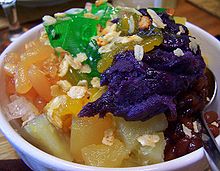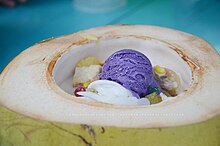food.wikisort.org - Dish
Halo-halo, correctly spelled haluhalo, Tagalog for "mixed" (the more common spelling instead literally equating to "mix-mix") is a popular cold dessert in the Philippines made up of crushed ice, evaporated milk or coconut milk, and various ingredients including ube jam (ube halaya), sweetened kidney or garbanzo beans, coconut strips, sago, gulaman (agar), pinipig, boiled taro or soft yams in cubes, flan, slices or portions of fruit preserves and other root crop preserves. The dessert is topped with a scoop of ube . It is usually prepared in a tall clear glass and served with a long spoon.[1] Halo-halo is considered to be the unofficial national dessert of the Philippines. The term "halo-halo" is supposed to mean "mixed" in English because the dessert is meant to be mixed before being consumed. Despite being strictly grammatically incorrect, this spelling has come to describe any object or situation composed of a similar, colorful combination of ingredients.
 A bowl of halo-halo | |
| Course | Dessert |
|---|---|
| Place of origin | Philippines |
| Main ingredients | Shaved ice, milk, various fruits |

History
The origin of halo-halo is traced to the pre-war Japanese Filipinos and the Japanese kakigōri class of desserts. One of the earliest versions of halo-halo was a dessert known locally as monggo kon-yelo or mongo-ya, which consisted of only mung beans (Tagalog: monggo or munggo, used in place of red azuki beans from Japan), boiled and cooked in syrup (minatamis na monggo), served on top of crushed ice with milk and sugar. Over time, more native ingredients were added, resulting in the creation and development of the modern halo-halo. One difference between halo-halo and its Japanese ancestor is the placement of ingredients mainly under the ice instead of on top of it. The original monggo kon-yelo type can still be found today, with similar variations using sweet corn (mais kon-yelo) or saba bananas (saba kon-yelo).[2][3][4][5]
Some authors specifically attribute halo-halo to the 1920s or 1930s Japanese migrants in the Quinta Market of Quiapo, Manila, due to its proximity to the Insular Ice Plant, Quiapo's main ice supply.[6] The Insular Ice Plant was built in 1902 by the Americans, which became the ice supplier for the Philippines. Although the ice plant was built, it was not the first introduction of ice in the Philippines. In the mid-19th century, the United States imported ice from Wenham Lake to different countries, including India, Australia, and the Philippines.[2][5]
The spelling of "halo-halo" is considered incorrect by the Commission on the Filipino Language, which prescribes "haluhalo." The word is an adjective meaning "mixed [together]" in Tagalog, a reduplication of the Tagalog verb halo "to mix."[7]
Description

There is no correct set of ingredients for halo-halo as the ingredients can vary widely, but the dessert usually includes sugar palm fruit (kaong), coconut sport (macapuno), saba plantains cooked in syrup (minatamis na saging), jackfruit (langkâ), agar jellies (gulaman), tapioca pearls, nata de coco, sweet potato (kamote), sweetened beans, cheese, pounded toasted young rice (pinipig), and ice cream. The ingredients are placed in specific positions; the fruit, beans, and other sweets are placed at the bottom, followed by shaved ice, and are then topped with either a combination of leche flan, ube halaya (mashed purple yam), or ice cream. Evaporated milk or coconut milk is poured into the mixture upon serving.[1][5] There are various local and regional varieties of Halo-halo that can be found throughout the country, which include different and/or additional ingredients than those previously listed, including sweetened wintermelon, durian, and strawberry ice cream, among others.[8]
A similar Visayan dessert binignit, commonly called bilo-bilo, is also referred to as "ginataang halo-halo" in Tagalog ("halo-halo in coconut milk"), commonly shortened to "ginataan." It is mostly the same ingredients, although the latter is usually served hot.[9][10]
In popular culture
Halo-halo was featured in season 1, episode 2 of Anthony Bourdain: Parts Unknown when its host Anthony Bourdain visited a Jollibee branch, a Filipino fast-food restaurant, in Los Angeles. Bourdain praised the dessert and called it "oddly beautiful". He also posted a photo of the dessert on his Twitter account.[11][12] The show featured the dessert again in season 7, episode 5 when Bourdain learns how Filipinos make the dessert.
Halo-halo was also featured as a Quickfire Challenge dish season 4, episode 7 of the American reality television series Top Chef. Filipino-American contestant Dale Talde prepared the dessert, which featured avocado, mango, kiwifruit, and nuts. Talde was named one of the top three Quickfire Challenge dishes by guest judge Johnny Iuzzinni of Jean Georges. Talde also made the dish in a later episode.[13]
The dessert was featured on a Delicious Destinations edition episode of Bizarre Foods.[14]
Halo-halo has a wide range of where it can be found, from food stands to 5-star hotels.[15] Filipino fast-food restaurants like Jollibee, Max's, and Chowking serve halo-halo.
See also
- Ais Kacang (ABC): Malaysian shaved ice
- Bingsu: Korean shaved ice
- Chè: Vietnamese sweet beverage
- Es campur and Es teler: Indonesian shaved ice
- Falooda: Indian cold dessert
- Grattachecca: Italian shaved ice popular in Rome.
- Hawaiian shave ice: Hawaiian shaved ice
- Kakigōri: Japanese shaved ice
- Namkhaeng sai and O-aew: Thai shaved ice
- Tshuah-ping: Taiwanese shaved ice
Other Filipino cold desserts:
References
- Roufs, Timothy G and Kathleen Smyth (2014). Sweet Treats Around the World: an Encyclopedia of Food and Culture : An Encyclopedia of Food and Culture. ABC-CLIO, LLC. pp. 267–271. ISBN 9781610692212.
- Ocampo, Ambeth R. "Japanese origins of the Philippine 'halo-halo'". Philippine Daily Inquirer. Retrieved April 23, 2019.
- "Halo-Halo Graham Float Recipe". Pinoy Recipe at Iba Pa. Retrieved July 24, 2019.
- FilipiKnow. "Halo-Halo: The Surprising Origin of Philippines' Beloved Dessert". FilipiKnow. Retrieved February 17, 2022.
- Valdeavilla, Ronica (March 13, 2018). "Halo-Halo: Favourite Dessert of The Philippines". Culture Trip. Retrieved February 17, 2022.
- Crisol, Christine (2006). "A Halo-Halo Menu". In Zialcita, Fernando N. (ed.). Quiapo: Heart of Manila. Manila: Quiapo Printing. p. 321. ISBN 978-971-93673-0-7.
Today, many non-Quiapense informants in their forties and older associate the Quinta Market with this dessert. Why did this market become important in the invention of this dessert? Aside from its being a Japanese legacy in the area [...] of all the city markets, the Quinta was closest to the ice.
- "KWF Diksiyonaryong Filipino". kwfdiksiyonaryo.ph. Retrieved February 10, 2022.
- "7 Unique HALO-HALO Versions around the Philippines". The Poor Traveler Itinerary Blog. April 15, 2020. Retrieved March 21, 2022.
- Merano, Vanjo. "Ginataang Halo-halo Recipe (Binignit)". Panlasang Pinoy.
- "Ginataan Halo-Halo". Filipino Food Recipes. Retrieved May 13, 2016.
- News, ABS-CBN (April 22, 2013). "Anthony Bourdain tries Jollibee halo-halo". ABS-CBN News. Retrieved November 2, 2020.
{{cite web}}:|last=has generic name (help) - Flores, Helen. "Jollibee in LA gets thumbs up". The Philippine Star. Retrieved April 24, 2013.
- "The Restaurant". Taldebrooklyn.com. Archived from the original on July 18, 2014. Retrieved June 9, 2014.
- Bizarre Foods with Andrew Zimmern#Season 18 - Delicious Destinations (Season 3.29
- Ocampo, Ambeth R. (August 30, 2012). "Japanese origins of the Philippine 'halo-halo'". INQUIRER.net. Retrieved February 18, 2022.
Further reading
- Connelly, Michael Alan (December 18, 2014). "20 Must-Try Street Foods Around the World". Fodor's. Retrieved July 24, 2016.
External links
- Halo-halo—from the Philippine Inquirer Internet Edition
- Halo-Halo: Business & Recipe for Success—Pinoy Bisnes Ideas
На других языках
- [en] Halo-halo
[ru] Хало-Хало
Хало-хало — популярный филиппинский холодный десерт, который представляет собой смесь из колотого льда, сгущённого молока и различных ингредиентов, включая подсолнечную фасоль, кокосовые полоски, саго, гуламан (желатин из морских водорослей), рис пинипиг, варёные корнеплоды в кубиках, кусочки фруктов, булочку, заправленную шариком мороженого.Другой контент может иметь иную лицензию. Перед использованием материалов сайта WikiSort.org внимательно изучите правила лицензирования конкретных элементов наполнения сайта.
WikiSort.org - проект по пересортировке и дополнению контента Википедии
